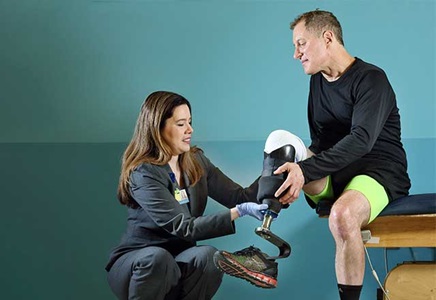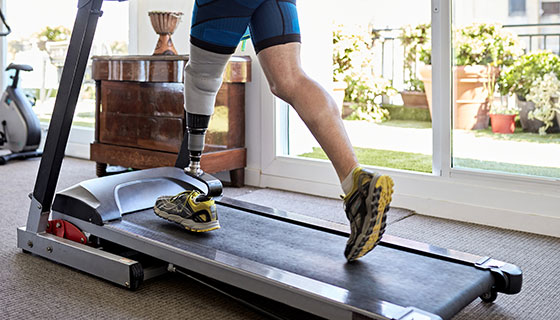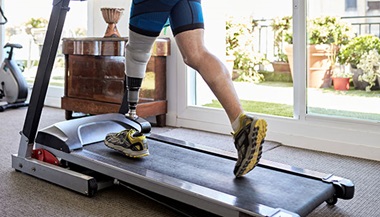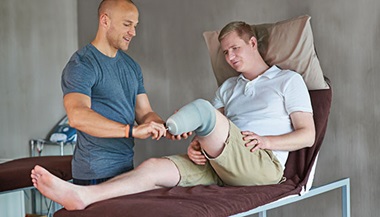What You Should Know Before Getting a Prosthetic Leg
Prosthetic legs, or prostheses, can help people with leg amputations get around more easily. They mimic the function and, sometimes, even the appearance of a real leg. Some people still need a cane, walker or crutches to walk with a prosthetic leg, while others can walk freely.
If you have a lower limb amputation, or you will soon, a prosthetic leg is probably an option you’re thinking about. There are a few considerations you should take into account first.
Not Everyone Benefits from a Prosthetic Leg
While many people with limb loss do well with their prosthetic legs, not everyone is a good candidate for a leg prosthesis. A few questions you may want to discuss with your doctor before opting for a prosthetic leg include:
- Is there enough soft tissue to cushion the remaining bone?
- How much pain are you in?
- What is the condition of the skin on the limb?
- How much range of motion does the residual limb have?
- Is the other leg healthy?
- What was your activity level before the amputation?
- What are your mobility goals?
The type of amputation (above or below the knee) can also affect your decision. It’s generally easier to use a below-the-knee prosthetic leg than an above-the-knee prosthesis. If the knee joint is intact, the prosthetic leg takes much less effort to move and allows for more mobility.
The reason behind the amputation is also a factor, as it may impact the health of the residual limb. Your physical health and lifestyle are also important to consider. If you were not very active and lost your leg due to peripheral vascular disease or diabetes, for example, you will struggle more with a prosthesis than someone who was extremely active but lost a limb in a car accident.
When it comes to amputation, each person is unique. The decision to move forward with a prosthesis should be a collaborative one between you and your doctor.
Prosthetic Legs Are Not One Size Fits All
If your doctor prescribes a prosthetic leg, you might not know where to begin. It helps to understand how different parts of a prosthesis work together:
- The prosthetic leg itself is made of lightweight yet durable materials. Depending on the location of the amputation, the leg may or may not feature functional knee and ankle joints.
- The socket is a precise mold of your residual limb that fits snugly over the limb. It helps attach the prosthetic leg to your body.
- The suspension system is how the prosthesis stays attached, whether through sleeve suction, vacuum suspension/suction or distal locking through pin or lanyard.
There are numerous options for each of the above components, each with their own pros and cons. “To get the right type and fit, it’s important to work closely with your prosthetist — a relationship you might have for life.
A prosthetist is a health care professional who specializes in prosthetic limbs and can help you select the right components. You’ll have frequent appointments, especially in the beginning, so it’s important to feel comfortable with the prosthetist you choose.
Rehabilitation Is an Ongoing, Collaborative Process
Once you’ve selected your prosthetic leg components, you will need rehabilitation to strengthen your legs, arms and cardiovascular system, as you learn to walk with your new limb. You’ll work closely with rehabilitation physicians, physical therapists and occupational therapists to develop a rehabilitation plan based on your mobility goals. A big part of this plan is to keep your healthy leg in good shape: while prosthetic technology is always advancing, nothing can replicate a healthy leg.
Getting Used to a Prosthetic Leg Isn’t Easy
Learning to get around with a prosthetic leg can be a challenge. Even after initial rehabilitation is over, you might experience some issues that your prosthetist and rehabilitation team can help you manage. Common obstacles include:
- Excessive sweating (hyperhidrosis), which can affect the fit of the prosthesis and lead to skin issues.
- Changing residual limb shape. This usually occurs in the first year after an amputation as the tissue settles into its more permanent shape, and may affect the fit of the socket.
- Weakness in the residual limb, which may make it difficult to use the prosthesis for long periods of time.
- Phantom limb pain could be intense enough to impact your ability to use the prosthesis.
A Note on Phantom Limb Pain
Phantom limb pain, or pain that seems to come from the amputated limb, is a very real problem that you may face after an amputation. About 80% of people with amputations experience phantom limb pain that has no clear cause, although pain in the limb before amputation may be a risk factor.
Mirror therapy, where you perform exercises with a mirror, may help with certain types of phantom limb pain. Looking at yourself in the mirror simulates the presence of the amputated leg, which can trick the brain into thinking it’s still there and stop the pain.
In other cases, phantom limb pain might stem from another condition affecting the residual limb, such as sciatica or neuroma. Addressing these root causes can help eliminate the phantom pain.
Your Leg Prosthesis Needs May Change
At some point, you may notice that you aren’t as functional as you’d like to be with your current leg prosthesis. Maybe your residual limb has stabilized and you’re ready to transition from a temporary prosthesis that lasts a few months to one that can last three to five years. Or maybe you’ve “outwalked” your prosthesis by moving more or differently than the prosthesis is designed for. New pain, discomfort and lack of stability are some of the signs that it may be time to check in with your prosthetist to reevaluate your needs.
Your prosthetist might recommend adjusting your current equipment or replacing one of the components. Or you might get a prescription for a new prosthetic leg, which happens on average every three to five years. If you receive new components, it’s important to take the time to understand how they work. Physical therapy can help adjust to the new components or your new prosthetic leg.
Prosthetic Leg Technology Is Always Evolving
There are always new developments in prosthetic limb technology, such as microprocessor-driven and activity-specific components.
- Microprocessor joints feature computer chips and sensors to provide a more natural gait. They may even have different modes for walking on flat surfaces or up and down the stairs.
- There are also specialized prosthetic legs for different activities, such as running, showering or swimming, which you can switch to as needed. In some cases, your everyday prosthetic leg can be modified by your prosthetist to serve different purposes.
- Osseointegration surgery is another option. This procedure involves the insertion of a metal implant directly into the bone, so there is no need for a socket. The prosthetic leg then attaches directly to that implant. While this procedure is not right for everyone and is still under study, it can provide improved range of motion and sensory perception.
It’s important to remember that you’re not alone in navigating the many different prosthetic leg options. Your care team will help you weigh the pros and cons of each and decide on the ideal prosthetic leg that matches your lifestyle.
Johns Hopkins Comprehensive Amputee Rehabilitation Program

Having the support of a dedicated team of experts is essential when recovering from the amputation of a limb. At Johns Hopkins, our team of physiatrists, orthotists, prosthetists, physical and occupational therapists, rehabilitation psychologists and other specialists works together to create your custom rehabilitation plan.






